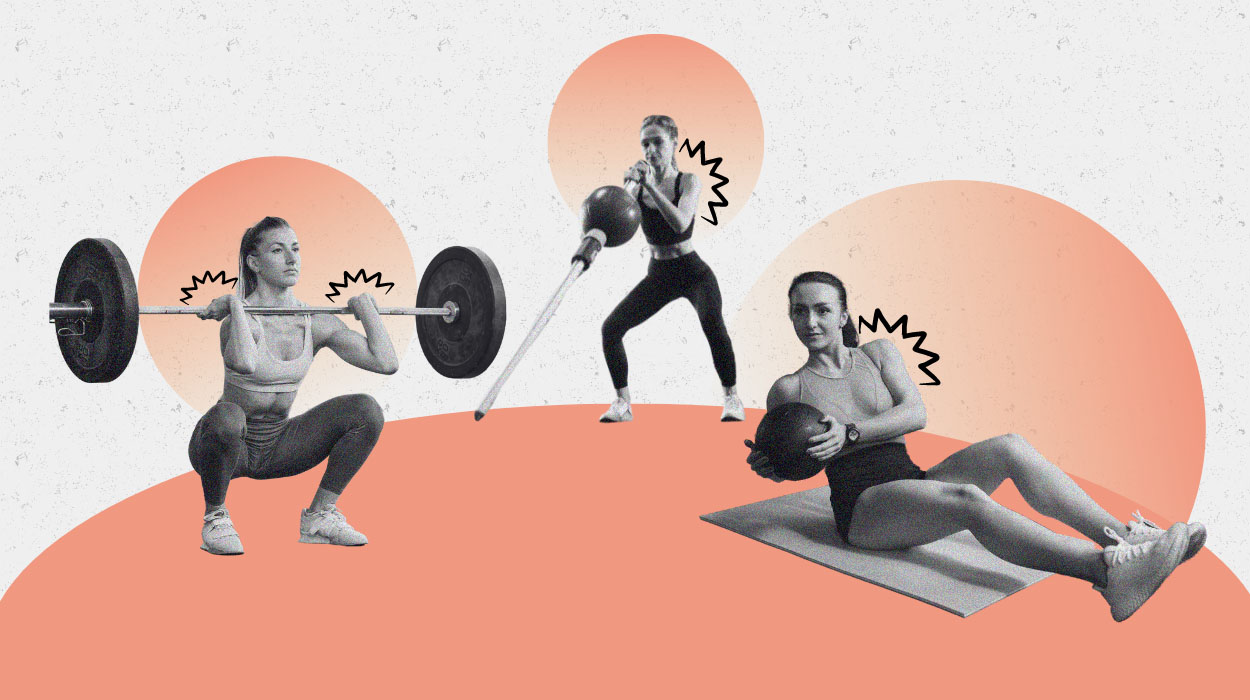
What do you think of when you hear the word core? Many people in the fitness industry associate this term with the abdominal muscles. However, the core consists of a large group of muscles.[1] These include the diaphragm, obliques, and rectus abdominis. Together, these muscles help to protect the spine and assist in force transfer. Functional core exercises help to enhance power development and movement quality.[2]
But functional core training isn’t just for athletes. They help to burn calories, too! This means they can contribute to weight loss alongside a healthy diet. Taking a vitamin formula and a fat burner can also help to achieve this goal quicker. Below, you’re going to discover the best 10 functional core strength exercises for a functional ab workout.
Best Functional Core Workout
Add these functional core exercises gym to your workout regimen to develop power and build muscle:
10 Best Functional Core Exercises You Should Try
Functional core workouts will help you get a six-pack. But you can expect many more benefits. Research links core training to better posture.[3] As forms of resistance exercise, these movements also help to improve mood.[4]
Add these exercises to your functional core training regimen over several weeks to feel the difference. Don’t forget to throw in some supplements for general well-being.
Pallof Press
Let’s start things off with the Pallof Press. This rotational exercise often appears in strength programs to increase core stability.[5]
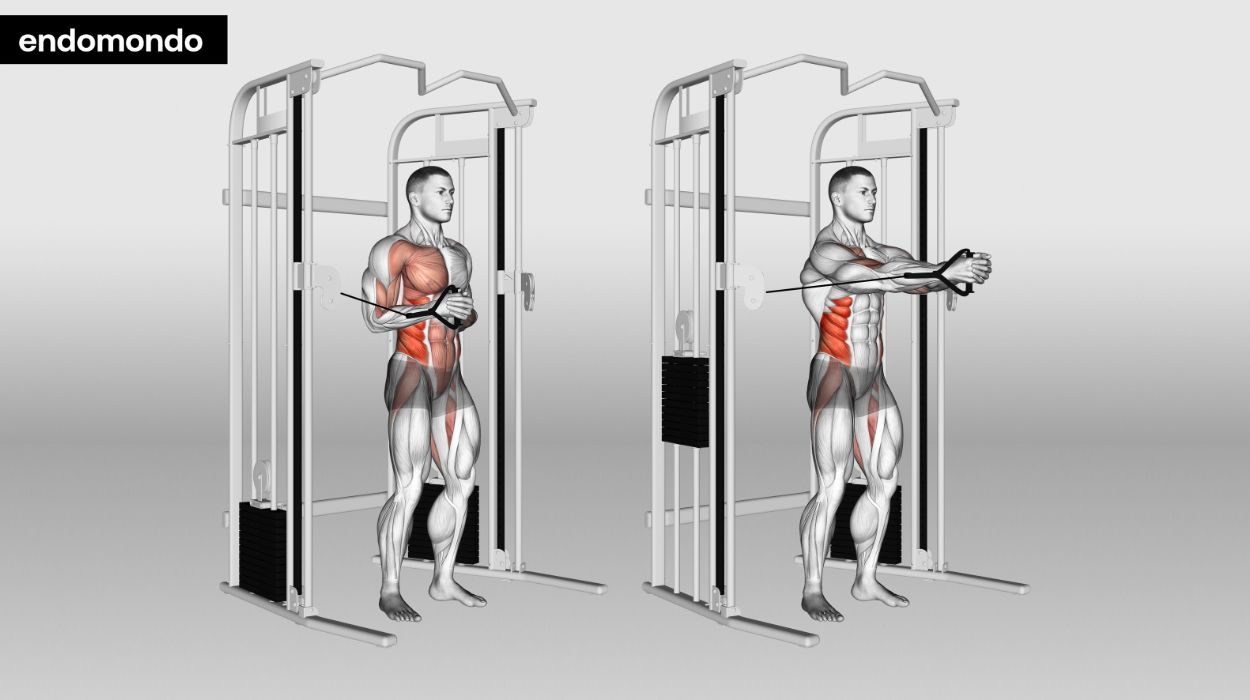
How to do:
- Adjust the handle on a cable machine or a resistance band to chest height.
- Take the starting position. Stand with your feet shoulder-width apart and knees slightly bent.
- Grab the handle with both hands and bring it to your chest.
- Engage core bracing.
- Press the handle outwards and bring it back in a slow and controlled way.
- Resist any rotations and keep your core as still as possible.
Tips:
- Maintain a stable and upright posture, engaging your core throughout to resist rotation.
- Start with a lighter resistance band or weight, focusing on control and stability before increasing intensity.
- Perform the exercise slowly and with control, emphasizing the anti-rotation aspect to target the core effectively.
Optimal Sets and Reps: 5 sets of 10 reps.
Bear Crawl
This dynamic full-body exercise engages multiple muscle groups, including the core. It helps to build leg, upper body, and core strength and stability.
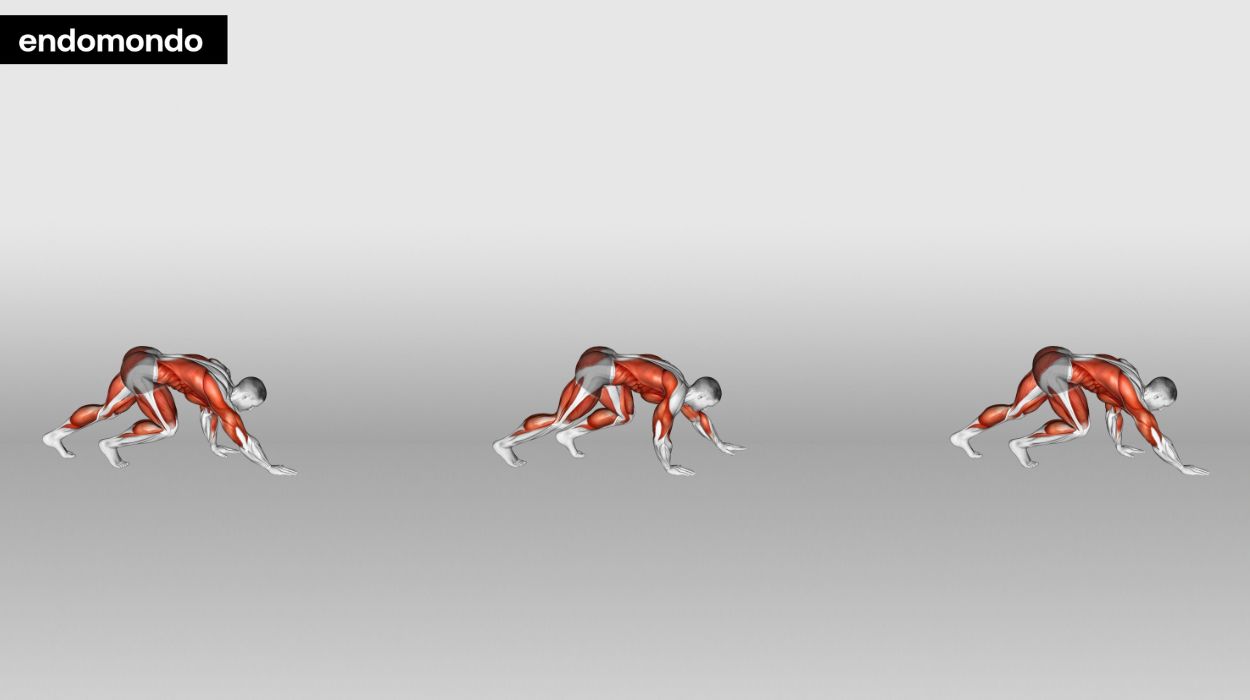
How to do:
- Take the starting position. Begin on all fours with your hands directly under your shoulders. Position your knees under your hips and wrists stacked under your shoulders.
- Engage your core to stabilize your spine and pelvis.
- Hover your knees several inches off the ground. Balance your weight evenly across your hands and feet.
- Take a step forward with your right hand and left foot. Follow it up with your left hand and right foot.
- Get into a rhythm and build up some speed.
- Complete 10 lengths of a 10 m stretch.
Tips:
- Maintain a neutral spine and engage your core to prevent excessive arching or rounding of your back.
- Keep your knees close to the ground and move with control to avoid unnecessary strain on your joints.
- Start with shorter distances and gradually increase as your stability and strength improve.
Optimal Sets and Reps: 3 sets of 20-30 seconds.
Landmine Rotations
Landmine rotations help to enhance core strength, with a particular focus on the obliques. It’s also one of the funniest core stability exercises!
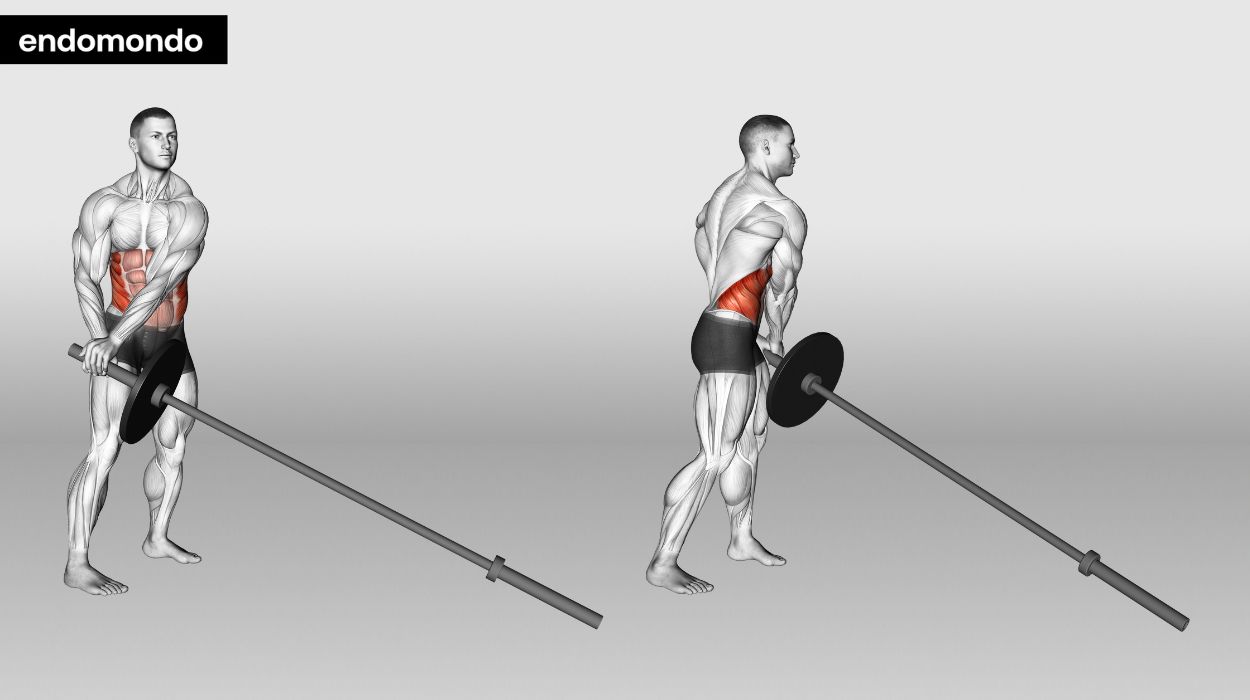
How to do:
- Slot the end of a barbell into a landmine device.
- Take the starting position by standing perpendicular to the barbell. Keep your feet shoulder-width apart. Hold the free end of the barbell with both hands at the center of your chest.
- Press the end of the barbell overhead.
- Bring the barbell down to your left hip. Keep your torso upright and pivot your right foot and hip. Rotate your torso towards the end of the barbell.
- Rotate out of this position and return to the press position.
- Repeat the movement on the other side.
Tips:
- Use your hips and core to generate the rotational force, rather than relying solely on your arms.
- Keep your feet shoulder-width apart and maintain a stable stance throughout the exercise.
- Avoid jerky movements; perform the rotations in a smooth, controlled fashion to minimize the risk of injury.
Optimal Sets and Reps: 5 sets of eight reps.
Kettlebell Russian Twists
This popular functional core training exercise targets the rectus abdominis, hip flexors, and obliques.
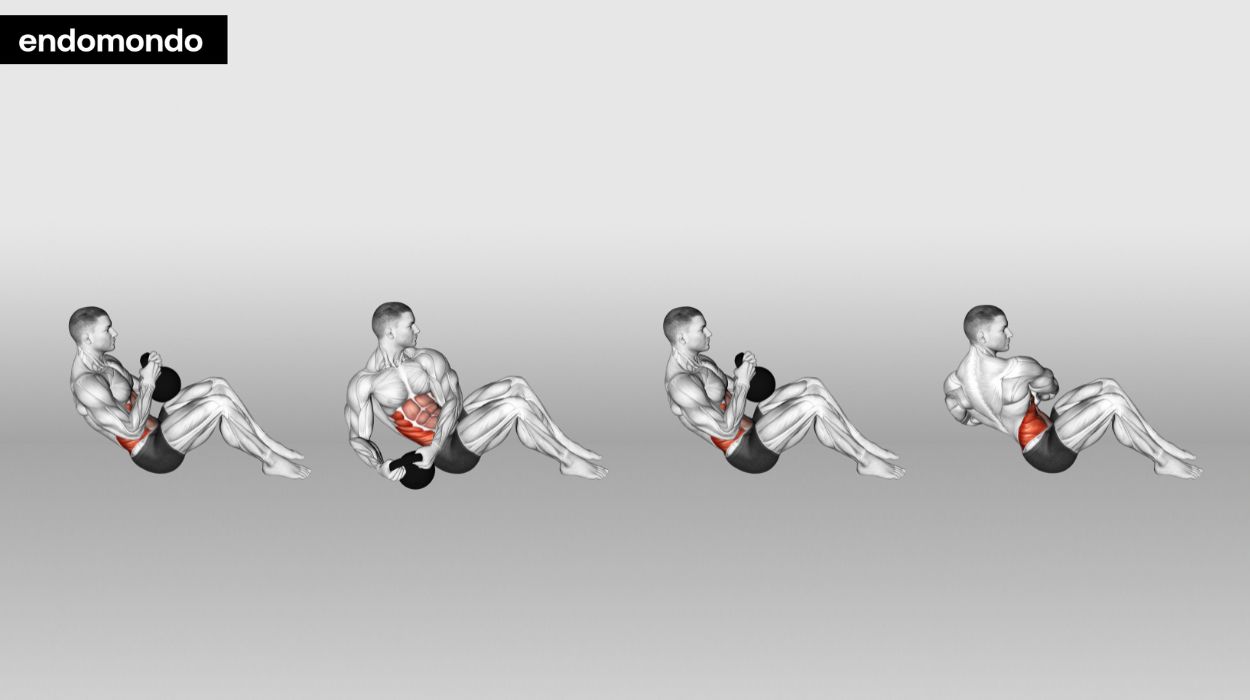
How to do:
- Grab a light kettlebell by the handle with both hands.
- Sit on the floor with your knees bent and feet flat on the ground. Lean your torso slightly backward.
- Move the kettlebell close to your chest.
- Brace your core muscles and keep a neutral spine.
- Rotate your core to the right.
- Repeat the movement on your left side.
Tips:
- Focus on controlled and deliberate twists, rather than rushing through the movement.
- Exhale as you twist and inhale as you return to the center to maintain proper breathing and core engagement.
- Ensure the weight or resistance is secure to prevent accidents during the exercise.
Optimal Sets and Reps: 5 sets of 12 reps.
One-Arm Farmers’ Carry
This exercise is a great alternative to deadlifts.[6] Holding the weight in one hand forces the core to work harder. See how you get on with this functional core exercises kettlebell workout.
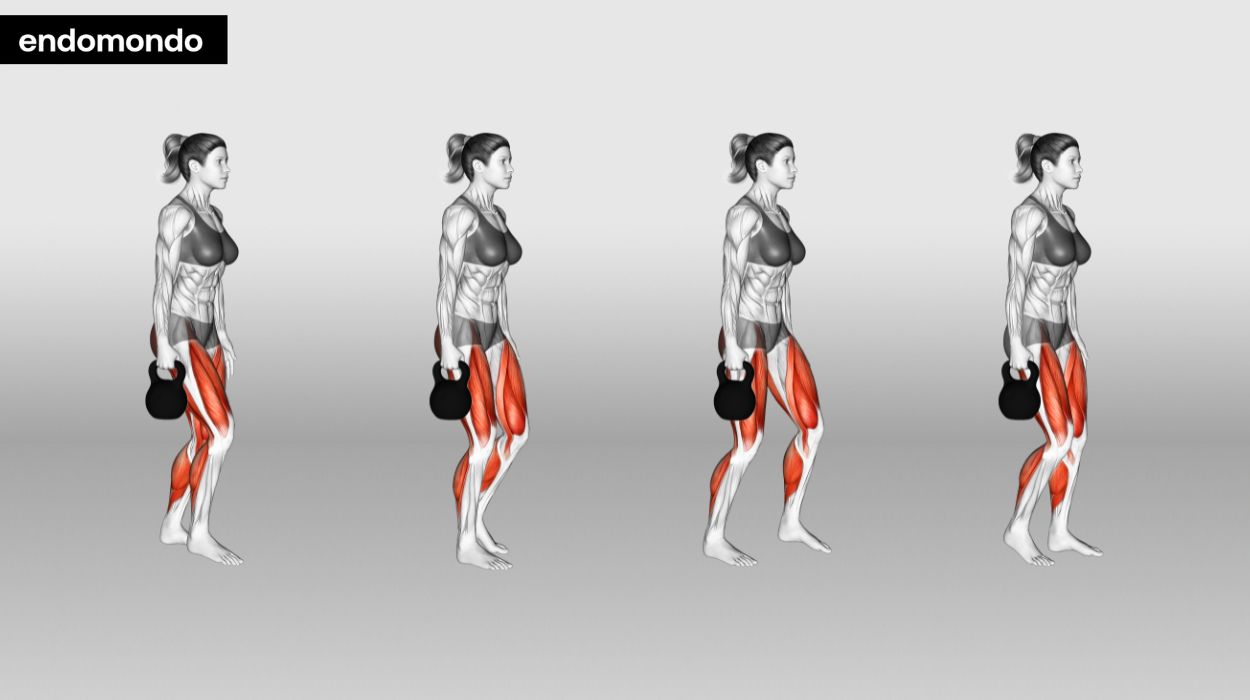
How to do:
- Start with a light kettlebell in one hand.
- Stand tall with your feet shoulder-width apart.
- Engage your core to stabilize and prevent the weight from pulling you to one side.
- Walk a length of 20m.
- Turn around and place the weight on the other hand.
Tips:
- Maintain an even weight distribution between both arms and avoid leaning to one side.
- Take small, controlled steps to prevent wobbling or swaying while carrying the weight.
- Gradually increase the weight as your grip strength and stability improve, challenging yourself progressively.
Optimal Sets and Reps: 4 sets of 20 meters per arm.
Front Squat
As a functional core training exercise, the front squat promotes core stability,[7] particularly among the spinal erectors.
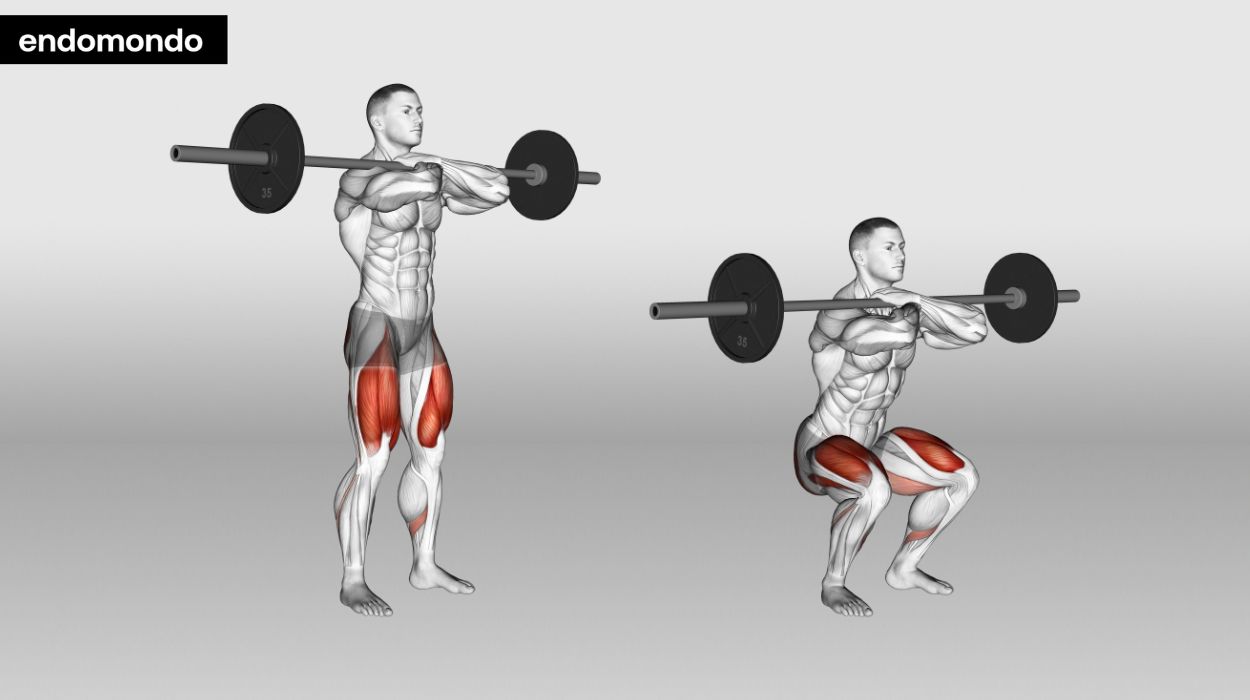
How to do:
- Rack the barbell by grabbing it loosely with an overhand grip.
- Swivel your elbows under the bar so that your upper arm is parallel to the floor.
- Allow the barbell to rest on your front delts to remove the load from your wrist.
- Take a step backward out of the rack.
- Stand with feet shoulder-width apart.
- Engage your abdominal muscles and slowly squat downwards until your upper legs become parallel to the floor.
- Return to the start position.
Tips:
- Keep your elbows high and chest up to maintain proper upper body position.
- Ensure your knees align with your toes, and avoid letting them collapse inward.
- Focus on controlled descents and ascents, avoiding rapid or jerky movements.
Optimal Sets and Reps: 5 sets of 5 reps.
Barbell Slings
This core training exercise recruits the obliques, glutes, adductors, and latissimus dorsi. These muscles and connective tissues make up anatomical slings[8] that assist in core rotation.
How to do:
- Hold a barbell with an underhand grip and hold it at the height of your belly button.
- Stand with legs shoulder-width apart.
- Step your left leg forward and put a bend in both knees. Keep your left foot flat when standing on the toes of your right foot.
- Keep your torso upright and rotate over your lead leg.
- As soon as you reach a maximal stretch, start to rotate in the other direction.
- Just as you start the rotation, jump and quickly swap the position of your legs as the barbell moves to the other side.
- Repeat this movement as you reach a maximal stretch on the right side.
Tips:
- Focus on maintaining an upright torso and a controlled range of motion throughout the exercise to avoid strain on your lower back and maintain balance.
- Begin with a light barbell or no added weight to get the technique and movement pattern down before progressing to heavier weights.
- As you become more proficient with the exercise, you can add more weight and speed to challenge yourself further.
Optimal Sets and Reps: 10 sets of 12 reps
Kettlebell Around The Worlds
This dynamic core training exercise engages the entire core, shoulders, and upper body.
How to do:
- Grab a light kettlebell and stand with feet hip-width apart.
- Hold a light kettlebell with both hands and straight arms, letting it hang freely.
- Engage your core and bring your shoulder blades back.
- Release the kettlebell into your left hand and swing it around to your back.
- Meet the kettlebell with your right hand and release your left.
- Swing the weight around to your front and meet it with your left hand.
- Repeat until you complete 10 full circles.
Tips:
- Maintain a stable grip on the kettlebell handle to prevent it from slipping during the exercise.
- Keep your shoulders relaxed and avoid shrugging to minimize tension in your neck and upper traps.
- Focus on controlling the kettlebell’s path and avoiding excessive momentum, especially as you pass it behind your back.
Optimal Sets and Reps: 10 sets of 10 reps.
Twist And Lunge Walks
This whole-body exercise works the core and associated connective tissue slings. It develops great core stability.
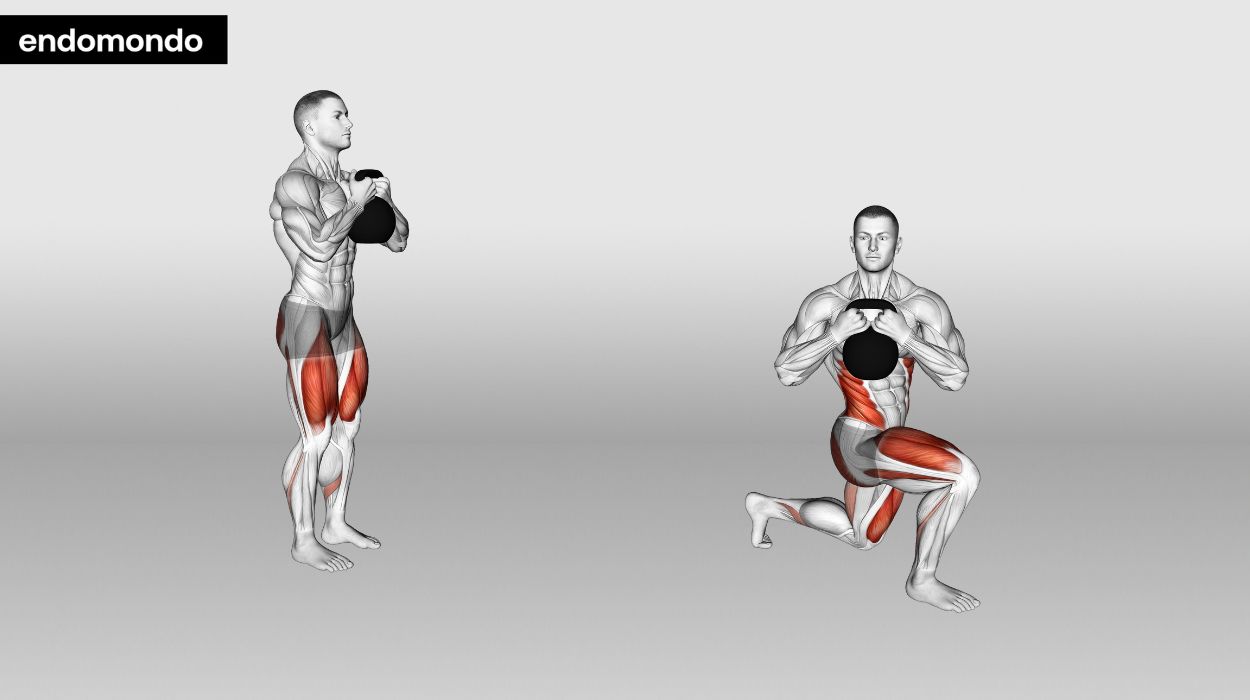
How to do:
- Hold the barbell with an underhand grip.
- Stand tall with your shoulder blades back and abdominal muscles engaged.
- Lunge forward with your left leg, rotating the barbell over it as you go.
- Once you hit maximal rotation, start to rotate to the right.
- During this movement, lunge forward with your right leg.
- Rotate the barbell over your lead leg.
- Continue until you complete 10 lunges in total.
Tips:
- Maintain proper alignment by keeping your knees in line with your ankles during lunges to protect your knee joints.
- Engage your glutes and quadriceps as you push back up from each lunge to maximize leg muscle activation.
- Keep your twists controlled and focus on rotating your torso, not just your arms, to work your obliques effectively.
Optimal Sets and Reps: 4 sets of 10-12 lunges (5-6 on each leg).
Straight Jabs
Boxing relies on core and hip rotation to generate powerful punches. Straight jabs develop core strength and core stability.
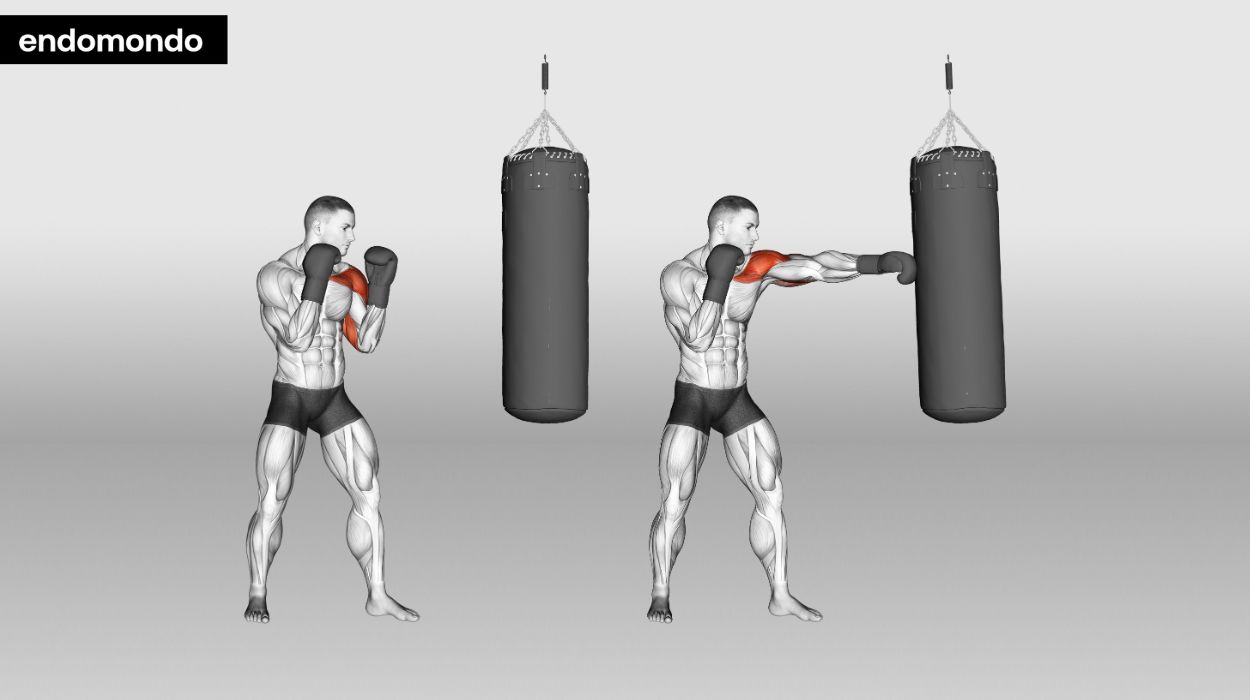
How to do:
- Put on thick boxing gloves and stand before a punching bag.
- Stand with feet shoulder-width apart.
- If you’re left-handed, put your right foot forward. If you’re right-handed, put your left foot forward.
- Hold both hands as a guard and chin level.
- Punch straight forward with your lead hand. Rotate into the punch at your core and hips.
- Perform 10 punches and then switch positions to jab with your other hand.
Tips:
- Protect your wrist by keeping it straight and not overextending when delivering the jabs.
- Rotate your hips and shoulders into each jab to maximize power and engage your core.
- Incorporate footwork by stepping forward and backward with each jab to simulate a boxing movement pattern effectively.
Optimal Sets and Reps: 10 sets of 20 reps.
What Are Functional Core Workouts?
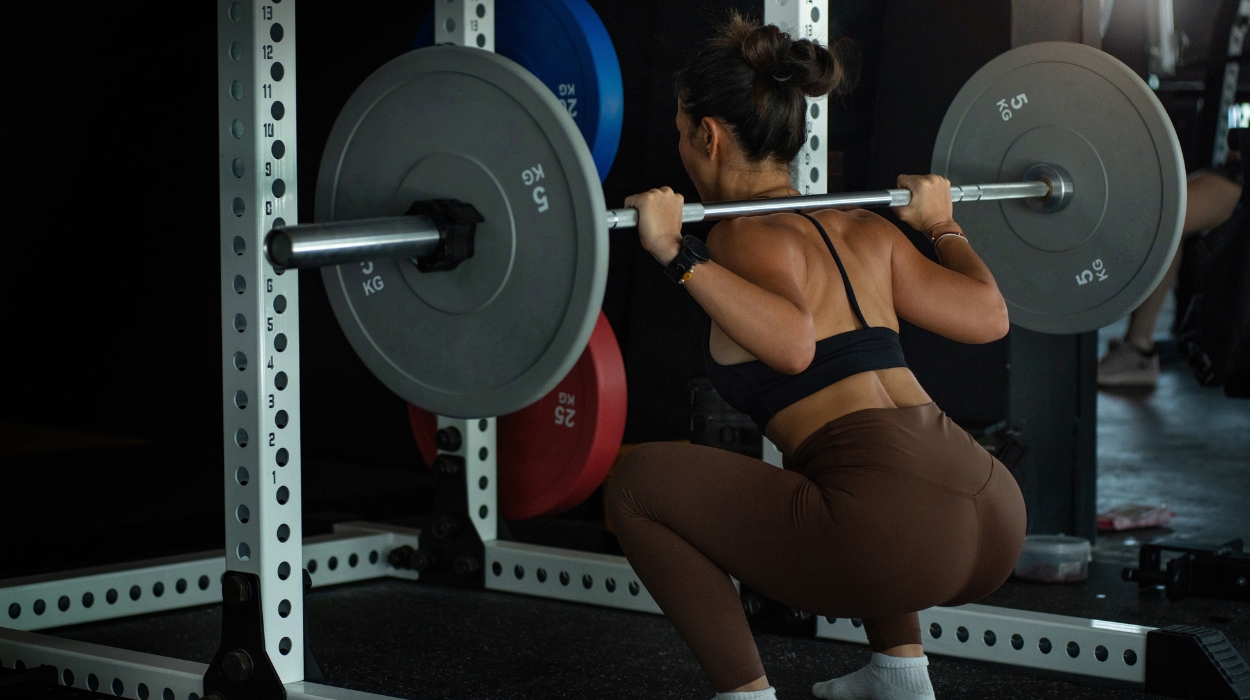
A functional core workout aims to challenge specific muscles. Each core exercise puts strain on the abs, obliques, and other supporting muscles. In response, these structures grow stronger and become more stable.
The 10 movements listed above engage the core. In doing so, they help with muscle-building, strength, and functional core training.
Common Mistakes And Precautions
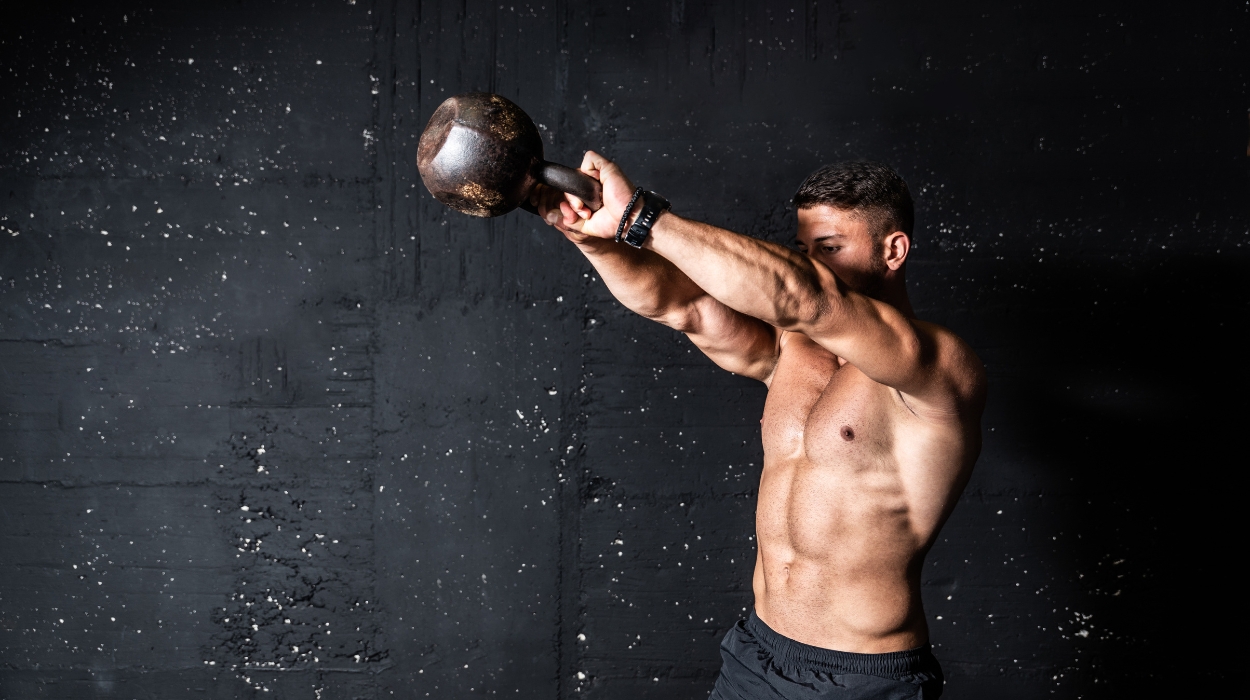
Consider these points for a safe and productive functional bodybuilding workout:
- Start slow: Perform each movement slowly and gradually build up speed. Being too explosive with an underdeveloped core can cause injury. Injury may result in some time spent in physical therapy to recover lost gains.
- Engage the core: Intentionally engage your abdominal muscles to protect your lower spine during all movements – crucial in strength training.
- Progress sets and reps: When you’re feeling ready, increase the sets or reps of each exercise. Your body will quickly adapt to each movement. Make it harder to force your body to keep adapting.
Final Thoughts
These exercises will help you burn calories and build strength. Barbell twists will help to improve overall functionality. Jabbing a punching bag will also build rotational power and grow your obliques.
Remember to avoid injury, and take things slow when you first start your movement patterns. Always be mindful of keeping your core engaged at all times. Finally, start to increase your sets and reps to challenge your body.
Frequently Asked Questions
Yes. They help to build a strong core. However, you’ll also need to monitor your calories.
No. You should break up your workout regimen to avoid injury to your core muscles.
These exercises will strengthen your muscles and make you more functional. They build power and rotational force.
Aim to perform core exercises around three days per week. This will give your body enough time to recover.
Resources
- Rathore, M., Trivedi, S., Abraham, J. and Sinha, M.S. (2017). Anatomical correlation of core muscle activation in different yogic postures. International Journal of Yoga, [online] 10(2), pp.59–59. doi:https://doi.org/10.4103/0973-6131.205515.
- Sajad Bagherian, Khodayar Ghasempoor, Rahnama, N. and Wikstrom, E.A. (2019). The Effect of Core Stability Training on Functional Movement Patterns in College Athletes. Journal of Sport Rehabilitation, [online] 28(5), pp.444–449. doi:https://doi.org/10.1123/jsr.2017-0107.
- Sibel Karacaoğlu and Fatma Çelik Kayapınar (2015). The Effect of Core Training on Posture. [online] ResearchGate. Available at: https://www.researchgate.net/publication/277897295_The_Effect_of_Core_Training_on_Posture [Accessed 12 Jan. 2024].
- Karen, H., Fogaça, S., Kil Sun Lee, Amaury Tavares Barreto, Santos, Helton, Sérgio Tufik and Túlio, M. (2016). Exercise deprivation increases negative mood in exercise-addicted subjects and modifies their biochemical markers. Physiology & Behavior, [online] 156, pp.182–190. doi:https://doi.org/10.1016/j.physbeh.2016.01.028.
- Wirth, K., Hartmann, H., Mickel, C., Szilvas, E., Keiner, M. and Sander, A. (2016). Core Stability in Athletes: A Critical Analysis of Current Guidelines. Sports Medicine, [online] 47(3), pp.401–414. doi:https://doi.org/10.1007/s40279-016-0597-7.
- Winwood, P.W., Cronin, J., Brown, S.R. and Keogh, J.W.L. (2015). A Biomechanical Analysis of the Farmers Walk, and Comparison with the Deadlift and Unloaded Walk. [online] ResearchGate. Available at: https://www.researchgate.net/publication/262300415_A_Biomechanical_Analysis_of_the_Farmers_Walk_and_Comparison_with_the_Deadlift_and_Unloaded_Walk.
- Bautista, D., Durke, D., Cotter, J.A., Escobar, K.A. and Schick, E.E. (2020). A Comparison of Muscle Activation Among the Front Squat, Overhead Squat, Back Extension and Plank. International journal of exercise science, [online] 13(1), pp.714–722. Available at: https://www.ncbi.nlm.nih.gov/pmc/articles/PMC7241624/.
- Santana, J.C., Mcgill, S.M. and Brown, L.E. (2015). Anterior and Posterior Serape. [online] ResearchGate. Available at: https://www.researchgate.net/publication/282407390_Anterior_and_Posterior_Serape.




